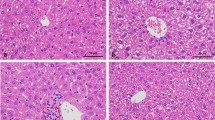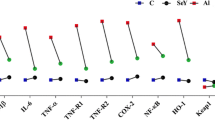Abstract
Aluminum (Al) poisoning is linked to the development of cardiovascular diseases, and dietary supplementation with selenium-rich-yeast (SeY) has been shown to prevent inflammatory conditions. We evaluated the preventive effect of SeY on Al-induced cardiotoxicity, and the possible underlying mechanisms. Mice were treated with SeY (0.1 mg/kg) and/or Al (10 mg/kg) by oral gavage for 4 weeks. Histopathological damage was observed in the heart of Al-treated mice, in addition to the transcriptional up/downregulation of nuclear xenobiotic receptors (NXRs), inflammatory cytokines and 15 CYP450s genes. SeY significantly inhibited these Al-induced histopathological and molecular changes, and restored these indicators to the control levels. These results suggest that SeY exerts a cardio-protective effect against Al-induced toxicity through the NXR system, inflammatory cytokines, and CYP450s genes.




Similar content being viewed by others
References
Exley C (2014) What is the risk of aluminium as a neurotoxin? Expert Rev Neurother 14(6):589–591
NÆae K, Hylland K, Oug E, Föourlin L, Ericson G (1999) Accumulation and effects of aluminum smelter—generated polycyclic aromatic hydrocarbons on soft—bottom invertebrates and fish. Environ Toxicol Chem 18(10):2205–2216
Rawy SM, Morsy GM, Elshibani MM (2013) Lethality, accumulation and toxicokinetics of aluminum in some tissues of male albino rats. Toxicol Ind Health 29(3):254–263
Elmazoudy RH, Bekhet GA (2016) In ovo toxico-teratological effects of aluminum on embryonic chick heart and vascularization. Environ Sci Pollut Res Int 23(21):1–10
Cheng D, Wang R, Wang C, Hou L (2017) Mung bean (Phaseolus radiatus L.) polyphenol extract attenuates aluminum-induced cardiotoxicity through an ROS-triggered Ca2+/JNK/NF-κB signaling pathway in rats. Food Funct 8(2):851–859
Kandimalla R, Vallamkondu J, Corgiat EB, Gill KD (2016) Understanding Aspects of Aluminum Exposure in Alzheimer's Disease Development. Brain Pathol 26(2):139–154
Cao Z, Wang P, Gao X, Shao B, Zhao S, Li Y (2019) Lycopene attenuates aluminum-induced hippocampal lesions by inhibiting oxidative stress-mediated inflammation and apoptosis in the rat. J Inorg Biochem 193:143–151
Wang H, Li X-N, Li P-C, Liu W, Du Z-H, Li J-L (2019) Modulation of heat-shock response is associated with Di (2-ethylhexyl) phthalate (DEHP)-induced cardiotoxicity in quail (Coturnix japonica). Chemosphere 214:812–820
Yao H-D, Wu Q, Zhang Z-W, Zhang J-L, Li S, Huang J-Q, Ren F-Z, Xu S-W, Wang X-L, Lei XG (2013) Gene expression of endoplasmic reticulum resident selenoproteins correlates with apoptosis in various muscles of se-deficient chicks. J Nutr 143(5):613–619
Yao H-D, Wu Q, Zhang Z-W, Li S, Wang X-L, Lei X-G, Xu S-W (2013) Selenoprotein W serves as an antioxidant in chicken myoblasts. Biochim Biophys Acta Gen Subj 1830(4):3112–3120
Zhang Z, Zheng Z, Cai J, Liu Q, Yang J, Gong Y, Wu M, Shen Q, Xu S (2017) Effect of cadmium on oxidative stress and immune function of common carp (Cyprinus carpio L.) by transcriptome analysis. Aquat Toxicol 192:171–177
Zhang Z, Liu Q, Cai J, Yang J, Shen Q, Xu S (2017) Chlorpyrifos exposure in common carp (Cyprinus carpio L.) leads to oxidative stress and immune responses. Fish Shellfish Immunol 67:604–611
Zhu SY, Li XN, Sun XC, Lin J, Li W, Zhang C, Li JL (2017) Biochemical characterization of the selenoproteome in Gallus gallus via bioinformatics analysis: structure-function relationships and interactions of binding molecules. Metallomics 9(2):124–131. https://doi.org/10.1039/c6mt00254d
Tirosh O, Levy E, Reifen R (2007) High selenium diet protects against TNBS-induced acute inflammation, mitochondrial dysfunction, and secondary necrosis in rat colon. Nutrition 23(11):878–886
Stoedter M, Renko K, Hög A, Schomburg L (2010) Selenium controls the sex-specific immune response and selenoprotein expression during the acute-phase response in mice. Biochem J 429(1):43–51
Sun Z, Xu Z, Wang D, Yao H, Li S (2018) Selenium deficiency inhibits differentiation and immune function and imbalances the Th1/Th2 of dendritic cells. Metallomics 10(5):759–767
Yang J, Zhang Y, Hamid S, Cai J, Liu Q, Li H, Zhao R, Wang H, Xu S, Zhang Z (2017) Interplay between autophagy and apoptosis in selenium deficient cardiomyocytes in chicken. J Inorg Biochem 170:17–25
Chi Q, Luan Y, Zhang Y, Hu X, Li S (2019) The regulatory effects of miR-138-5p on selenium deficiency-induced chondrocyte apoptosis are mediated by targeting SelM. Metallomics
Huang Z, Rose AH, Hoffmann PR (2012) The role of selenium in inflammation and immunity: from molecular mechanisms to therapeutic opportunities. Antioxid Redox Signal 16(7):705–743
Mertens K, Lowes DA, Webster NR, Talib J, Hall L, Davies MJ, Beattie JH, Galley HF (2015) Low zinc and selenium concentrations in sepsis are associated with oxidative damage and inflammation. Br J Anaesth 114(6):990–999
Yin K, Yang Z, Gong Y, Wang D, Lin H (2019) The antagonistic effect of Se on the Pb-weakening formation of neutrophil extracellular traps in chicken neutrophils. Ecotoxicol Environ Saf 173:225–234
Zhang C, Lin J, Ge J, Wang L-L, Li N, Sun X-T, Cao H-B, Li J-L (2017) Selenium triggers Nrf2-mediated protection against cadmium-induced chicken hepatocyte autophagy and apoptosis. Toxicol in Vitro 44:349–356
Briens M, Mercier Y, Rouffineau F, Vacchina V, Geraert PA (2013) Comparative study of a new organic selenium source v. seleno-yeast and mineral selenium sources on muscle selenium enrichment and selenium digestibility in broiler chickens. Br J Nutr 110(4):617–624
Di MA, De ME, Ascenzi P, Marino M (2009) Nuclear receptors CAR and PXR: molecular, functional, and biomedical aspects. Mol Asp Med 30(5):297–343
Moreau A, Vilarem MJ, Maurel P, Pascussi JM (2008) Xenoreceptors CAR and PXR activation and consequences on lipid metabolism, glucose homeostasis, and inflammatory response. Mol Pharm 5(1):35–41
Sui Y, Xu J, Rios-Pilier J, Zhou C (2011) Deficiency of PXR decreases atherosclerosis in apoE-deficient mice. J Lipid Res 52(9):1652–1659
Li XN, Zuo YZ, Qin L, Liu W, Li YH, Li JL (2018) Atrazine-xenobiotic nuclear receptor interactions induce cardiac inflammation and endoplasmic reticulum stress in quail ( Coturnix coturnix coturnix ). Chemosphere
Du ZH, Xia J, Sun XC, Li XN, Zhang C, Zhao HS, Zhu SY, Li JL (2017) A novel nuclear xenobiotic receptors (AhR/PXR/CAR)-mediated mechanism of DEHP-induced cerebellar toxicity in quails ( Coturnix japonica ) via disrupting CYP enzyme system homeostasis ☆. Environ Pollut 226
Zheng S, Jin X, Chen M, Shi Q, Zhang H, Xu S (2019) Hydrogen sulfide exposure induces jejunum injury via CYP450s/ROS pathway in broilers. Chemosphere 214:25–34
Kliewer SA, Goodwin B, Willson TM (2002) The nuclear pregnane X receptor: a key regulator of xenobiotic metabolism. Endocr Rev 23(5):687–702
Lai IK, Chai Y, Simmons D, Watson WH, Tan R, Haschek WM, Wang K, Wang B, Ludewig G, Robertson LW (2011) Dietary selenium as a modulator of PCB 126–induced hepatotoxicity in male Sprague-Dawley rats. Toxicological Sciences An Official Journal of the Society of Toxicology 124(1):202–214
Tsujimoto S, Ishida T, Takeda T, Ishii Y, Onomura Y, Tsukimori K, Takechi S, Yamaguchi T, Uchi H, Suzuki SO (2013) Selenium-binding protein 1: Its physiological function, dependence on aryl hydrocarbon receptors, and role in wasting syndrome by 2,3,7,8-tetrachlorodibenzo- p -dioxin. Biochim Biophys Acta 1830(6):3616–3624
Shen H, Li M, Wang B, Lai IK, Robertson LW, Ludewig G (2014) Dietary antioxidants (selenium and N-acetylcysteine) modulate paraoxonase 1 (PON1) in PCB 126-exposed rats. Environ Sci Pollut Res 21(10):6384–6399
Zhang L, Gao J (2003) Comparison on intake status of harmful elements between China and some developed countries. Journal of Hygiene Research 32(3):268
Giorgianni C, Faranda M, Brecciaroli R, Beninato G, Saffioti G, Muraca G, Congia P, Catanoso R, Agostani G, Abbate C (2003) Cognitive disorders among welders exposed to aluminum. G Ital Med Lav Ergon 25(Suppl (3)):102
Kuznetsova IA, Areshidze DA, Kozlova MA (2017) The influence of different aluminium compounds on the hippocampal morphofunctional state and conditioning in mice. Toxicol Environ Heal Sci 9(3):215–221
Cheng D, Zhang X, Xu L, Li X, Hou L, Wang C (2017) Protective and prophylactic effects of chlorogenic acid on aluminum-induced acute hepatotoxicity and hematotoxicity in mice. Chem Biol Interact 273:125–132
Cao C, Luo J, Li X, Zhang M, Zhang H, Zhang J, Wang K (2018) Selenium-rich yeast protects against aluminum-induced renal inflammation and ionic disturbances. Biol Trace Elem Res:1-7
Yang JQ, Liu BZ, He BC, Zhou QQ (2006) Protective effects of meloxicam on aluminum overload-induced cerebral damage in mice. Eur J Pharmacol 547(1–3):52–58
Chambrun GP, Vignal C, Body-Malapel M, Djouina M, Altare F, Arrieta MC, Cortot A, Colombel JF, Neut C, Desreumaux P (2014) S02 Aluminum enhances inflammation and decreases healing in experimental models of colitis. Gastroenterology 140(5):589–601
Brule SVD, Beckers E, Chaurand P, Liu W, Ibouraadaten S, Palmaipallag M, Uwambayinema F, Yakoub Y, Avellan A, Levard C (2014) Nanometer-long Ge-imogolite nanotubes cause sustained lung inflammation and fibrosis in rats. Part Fibre Toxicol 11(1):67
Kaur P, Sodhi RK (2015) Memory recuperative potential of rifampicin in aluminum chloride-induced dementia: role of pregnane X receptors. Neuroscience 288:24–36
Huai W, Zhao R, Song H, Zhao J, Zhang L, Zhang L, Gao C, Han L, Zhao W (2014) Aryl hydrocarbon receptor negatively regulates NLRP3 inflammasome activity by inhibiting NLRP3 transcription. Nat Commun 5:4738
Tanner N, Kubik L, Luckert C, Thomas M, Hofmann U, Zanger UM, Böhmert L, Lampen A, Braeuning A (2018) Regulation of drug metabolism by the interplay of inflammatory signaling, steatosis, and xeno-sensing receptors in HepaRG cells. Drug Metab Dispos 46(4):326–335
Ansar S (2016) Effect of selenium on the levels of cytokines and trace elements in toxin-mediated oxidative stress in male rats. Biol Trace Elem Res 169(1):129–133
Duntas LH, Hubalewska-Dydejczyk A (2015) Selenium and inflammation— potential use and future perspectives. Us Endocrinology 11(2):97
Lin J, Zhao H-S, Qin L, Li X-N, Zhang C, Xia J, Li J-L (2018) Atrazine triggers mitochondrial dysfunction and oxidative stress in quail (Coturnix C. coturnix) cerebrum via activating xenobiotic-sensing nuclear receptors and modulating cytochrome P450 systems. J Agric Food Chem 66(25):6402–6413
Al-Attas OS, Hussain T, Ahmed M, Al-Daghri N, Mohammed AA, Rosas ED, Gambhir D, Sumague TS (2015) Ultrastructural changes, increased oxidative stress, inflammation, and altered cardiac hypertrophic gene expressions in heart tissues of rats exposed to incense smoke. Environ Sci Pollut Res 22(13):1–11
Zhu Y, Han Y, Zhao H, Li J, Hu C, Li Y, Zhang Z (2013) Suppressive effect of accumulated aluminum trichloride on the hepatic microsomal cytochrome P450 enzyme system in rats. Food Chem Toxicol 51(1):210–214
Peng F, Guo X, Li Z, Li C, Wang C, Lv W, Wang J, Xiao F, Kamal MA, Yuan C (2016) Antimutagenic effects of selenium-enriched polysaccharides from Pyracantha fortuneana through suppression of cytochrome P450 1A subfamily in the mouse liver. Molecules 21 (12)
Sun LH, Zhang NY, Zhu MK, Zhao L, Zhou JC, Qi DS (2016) Prevention of aflatoxin B1 hepatoxicity by dietary selenium is associated with inhibition of cytochrome P450 isozymes and up-regulation of 6 selenoprotein genes in chick liver. J Nutr 146(4)
Funding
This work was supported by Foshan University research star-up project (099/CGZ07276), Foshan University lingnan Scholars Launch Project (099/CGZ07084), and Key Laboratory of preventive veterinary medicine in Guangdong Provincial Department of Education (2014KTSPT037).
Author information
Authors and Affiliations
Corresponding author
Ethics declarations
All animal studies reported here were approved by the Institutional Animal Care and Use Committee of the Foshan University.
Conflict of Interest
The authors declare that there are no conflicts of interest.
Additional information
Publisher’s Note
Springer Nature remains neutral with regard to jurisdictional claims in published maps and institutional affiliations.
Rights and permissions
About this article
Cite this article
Cao, C., Li, X., Fu, Q. et al. Selenium-Rich-Yeast Protects Against Aluminum-Induced Activating Nuclear Xenobiotic Receptors and Triggering Inflammation and Cytochromes P450 Systems in Mice Heart. Biol Trace Elem Res 194, 244–250 (2020). https://doi.org/10.1007/s12011-019-01763-x
Received:
Accepted:
Published:
Issue Date:
DOI: https://doi.org/10.1007/s12011-019-01763-x




